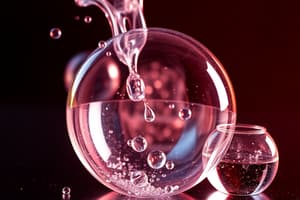Podcast
Questions and Answers
Which of the following is an example of a renewable resource?
Which of the following is an example of a renewable resource?
- Natural gas
- Coal
- Solar energy (correct)
- Nuclear energy
Which of the following is an example of a chemical change?
Which of the following is an example of a chemical change?
- Burning paper (correct)
- Melting ice
- Cutting a piece of wood
- Mixing salt and water
Which of the following is an example of a physical change?
Which of the following is an example of a physical change?
- Rusting of iron
- Baking a cake (correct)
- Cooking an egg
- Digesting food
Which of the following is NOT a characteristic of a physical change?
Which of the following is NOT a characteristic of a physical change?
Which of the following is an example of a nonrenewable resource?
Which of the following is an example of a nonrenewable resource?
Which of the following is NOT a characteristic of a chemical change?
Which of the following is NOT a characteristic of a chemical change?
Flashcards
Renewable Resource
Renewable Resource
A resource that can be replenished naturally over a relatively short period of time, such as solar energy, wind energy, or hydropower.
Chemical Change
Chemical Change
A change that alters the chemical composition of a substance, resulting in the formation of new substances. Examples include burning, rusting, and cooking.
Physical Change
Physical Change
A change in the physical state or appearance of a substance, but not its chemical composition. Examples include melting, freezing, boiling, and cutting.
Nonrenewable Resource
Nonrenewable Resource
Signup and view all the flashcards
Change in State
Change in State
Signup and view all the flashcards
Formation of a new substance
Formation of a new substance
Signup and view all the flashcards
Study Notes
Renewable and Non-Renewable Resources
- A renewable resource is a natural resource that can be replenished over time.
- Examples of renewable resources include solar energy, wind energy, and water.
Chemical Changes
- A chemical change is a process that alters the chemical composition of a substance.
- Examples of chemical changes include burning fossil fuels, rusting of iron, and digestion of food.
Physical Changes
- A physical change is a process that alters the state or form of a substance without changing its chemical composition.
- Examples of physical changes include melting of ice, boiling of water, and condensation of steam.
Characteristics of Physical and Chemical Changes
- A characteristic of a physical change is that it is reversible.
- A characteristic of a chemical change is that it is often irreversible and releases or absorbs energy.
- A characteristic that is NOT typical of a physical change is a change in chemical composition.
- A characteristic that is NOT typical of a chemical change is reversibility.
Studying That Suits You
Use AI to generate personalized quizzes and flashcards to suit your learning preferences.




